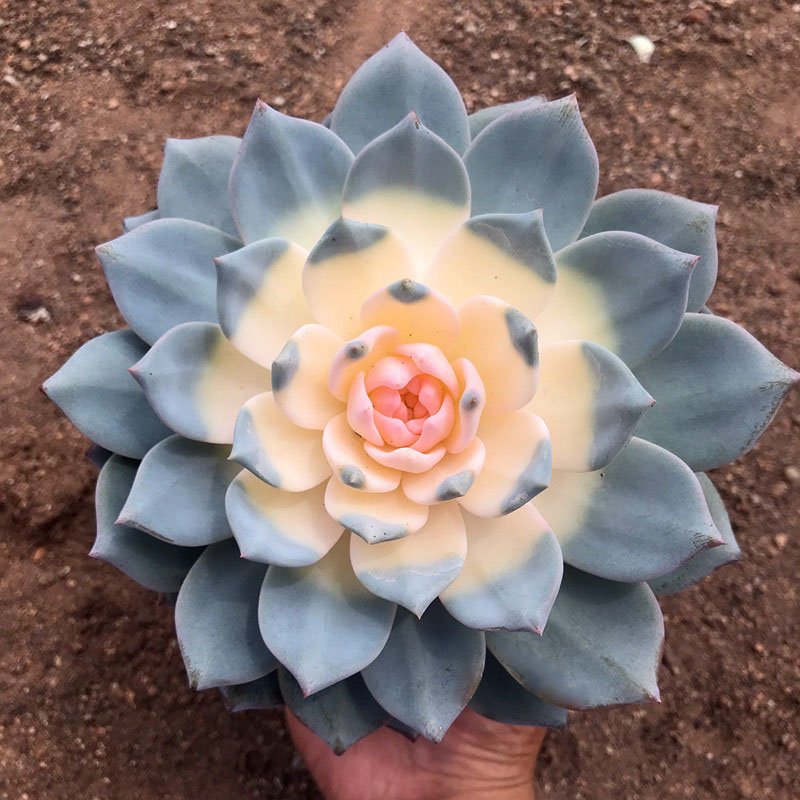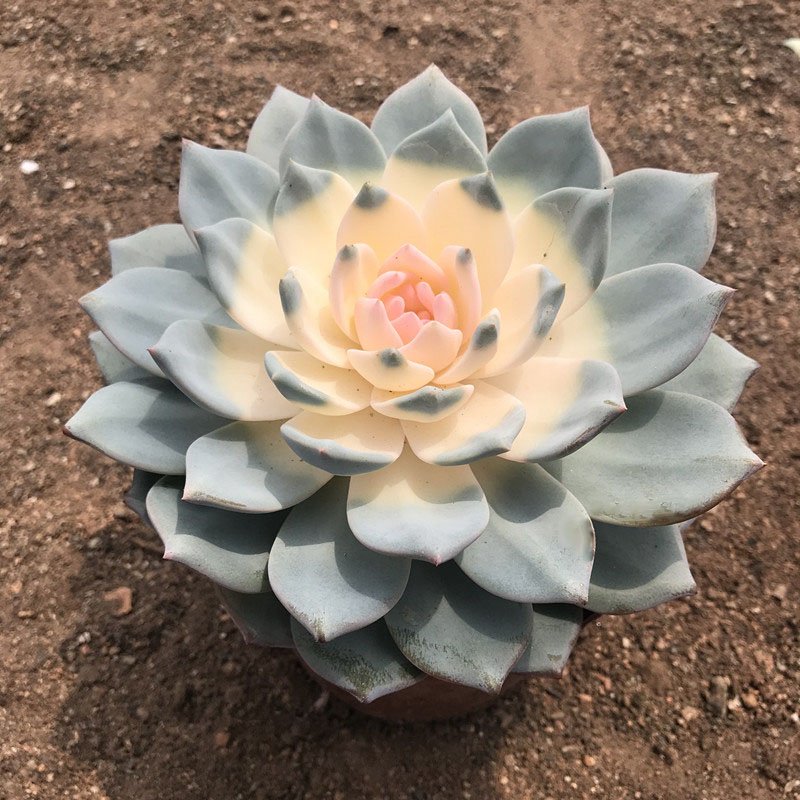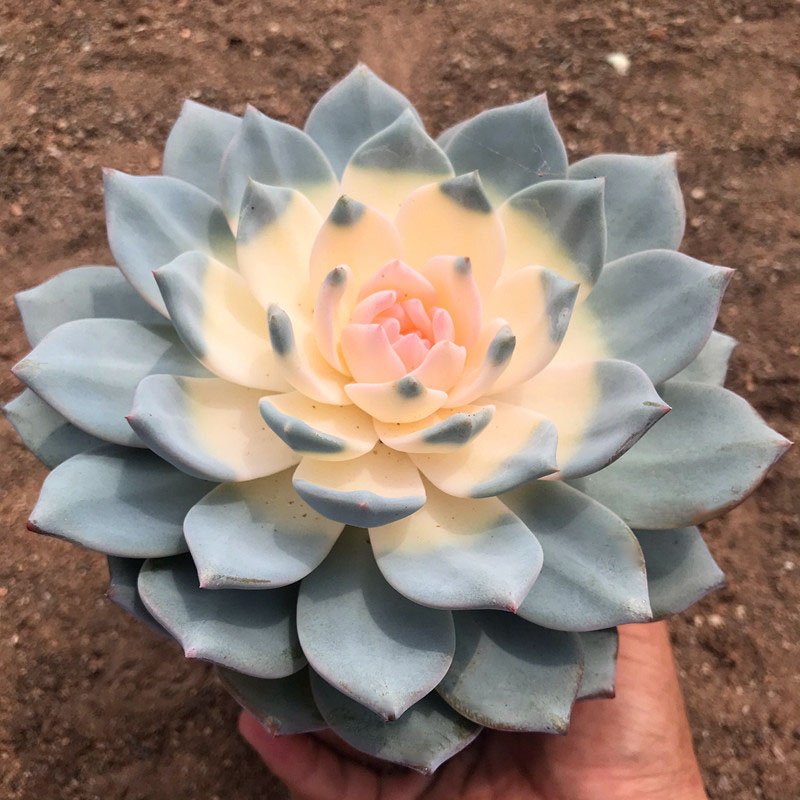
Echeveria Blue Bird variegated grows best with bright light and soil that drains well. Put your succulent near a window so it keeps its strong colors and healthy leaves. Only water when the soil feels dry, because too much water can make the leaves soft or see-through. Always use pots with holes at the bottom, not just pebbles, to stop root rot. Slowly let your echeveria blue bird variegated get used to more sunlight, because too much sun at once can burn it. This care guide helps you avoid mistakes and keep your succulent healthy.
Key Takeaways
- Put your Echeveria Blue Bird variegated in bright, indirect sunlight for 6 to 8 hours each day. This helps keep its colors bright and stops it from stretching.
- Water the plant deeply, but only when the soil feels dry. This helps stop root rot. Always use pots with drainage holes. Use soil that drains well and has mineral grit.
- Cut off dead or crowded leaves in spring or autumn. This helps air move around the plant. It also keeps away pests and helps the plant grow well.
- You can make new plants by using healthy leaves or offsets. Let the cuttings dry before you plant them. This helps stop rot.
- Look out for pests and sunburn. Treat bugs early. Slowly give your plant more sunlight to keep it safe from damage.
Echeveria Blue Bird Variegated Care

Light Needs
You help your echeveria blue bird variegated thrive by giving it the right amount of light. Place your succulent where it gets bright, indirect sunlight for most of the day. Direct sun for 5 to 6 hours works well, but you should avoid harsh afternoon rays, especially in hot climates. Too much direct sunlight can burn the leaves and cause discoloration. If you grow your plant indoors, aim for a spot with light intensity between 400 and 800 foot-candles. Lower light levels, below 200 foot-candles, make the plant stretch and lose its compact shape.
Tip: Filtered light or a sheer curtain protects your echeveria blue bird variegated from sunburn while still keeping its colors bright. In full sun to partial shade, the leaves show more red, pink, or purple tones. In deep shade, the leaves turn greener and may lose their unique variegation.
Both variegated and standard Blue Bird types need the same light care. Gradually move your plant into brighter spots so it can adjust without stress.
Watering Tips
Watering your echeveria blue bird variegated the right way keeps it healthy. Always let the soil dry out before you water again. Most growers find that watering every 12 days with about half a cup of water works for a 5-inch pot, but you should adjust this based on your climate and pot size. In winter or cloudy weather, water less often. Smaller pots dry out faster, so check them more often.
Never mist your succulent. Water at the base, not on the leaves, to avoid rot. Deep watering with good drainage helps roots grow strong. Use moderate amounts of water and make sure extra water can escape.
Here is a quick comparison of what happens if you overwater or underwater your echeveria blue bird variegated:
| Condition | Impact on Root Health and Plant Signs |
|---|---|
| Overwatering | Roots rot, leaves turn mushy and brown, plant becomes weak. |
| Underwatering | Leaves shrivel, soil feels dry, roots stay healthy but dry. |
Overwatering causes more harm than underwatering. Always check the soil before you water.
Soil and Pot
The right soil and pot keep your echeveria blue bird variegated safe from root rot. Use a potting soil mix with 50-70% mineral grit, such as perlite, pumice, or coarse sand. This mix lets water drain quickly and gives roots air. Always choose pots with drainage holes. These holes let extra water escape and protect your succulent from soggy roots.
Note: While some people use pots without drainage holes, this method needs careful watering and a thick layer of pebbles or charcoal at the bottom. For beginners, pots with drainage holes are much safer.
Both the variegated and standard Blue Bird need the same soil and pot care. Good drainage and the right potting soil mix help your plant grow strong and colorful.
Maintenance
Pruning
Pruning helps your Echeveria Blue Bird variegated stay healthy and look its best. You should prune during spring or autumn, when the plant grows most actively. Always use sharp, clean scissors or pruning shears. Wipe the blades with alcohol before you start. This step keeps bacteria away from your plant.
Follow these steps for effective pruning:
- Check your plant for half-dried or downward-turned leaves. Remove these leaves to improve air flow and prevent pests.
- Trim dense leaves from the middle and bottom. This action helps moisture evaporate and reduces the risk of fungus.
- Cut off spent flowers right away. This saves energy for new growth.
- After pruning, apply a light fungicide to the cut areas. Place your plant in a spot with good air movement.
- Keep your plant out of direct sunlight for a few days. Slowly return it to brighter light.
- Water less often until the cuts heal. Then, return to your normal watering schedule.
- Use a gentle organic fertilizer to help your plant recover and grow new buds.
Tip: You do not need to remove every dead leaf. Lower leaves can protect your plant from sun and cold. Remove them only if you see pests or signs of disease.
Regular pruning encourages side buds and prevents overcrowding. This keeps your Echeveria Blue Bird variegated strong and attractive.
Repotting
You should repot your Echeveria Blue Bird variegated when it outgrows its pot or doubles in size. Repotting once a year also helps if the soil loses nutrients. If you buy a new plant in a small pot, repot it soon after bringing it home.
Look for these signs that your plant needs repotting:
- Roots grow out of the drainage holes.
- The plant looks crowded or top-heavy.
- Soil dries out too quickly or stays soggy.
To repot with minimal stress:
- Water your plant about 12 hours before repotting.
- Choose a pot just a bit larger than the old one. Fill it with fresh, peat-free cactus soil.
- Gently remove the plant and shake off old soil.
- Place the rootball on new soil and fill in the gaps. Do not press the soil down hard.
- Water until you see water drain from the holes. Let the pot drain for 10 minutes before putting it back.
Note: Air roots sometimes grow above the soil. These roots help your plant stay stable and are not a sign of trouble.
Propagation

Leaf Method
You can grow new Echeveria Blue Bird variegated plants from healthy leaves. Choose mature leaves with stable variegation for the best chance of success. Leaves with strong color patterns often produce similar offspring. Gently twist a leaf from the stem, making sure you get the whole base. Let the leaf dry for a few days until the end forms a callus. This step helps prevent rot.
Several factors help your leaf cuttings root and grow:
- Bright, indirect sunlight keeps the leaf healthy and prevents sunburn. Avoid harsh, direct sun, especially for leaves with white or pale areas.
- Use well-draining soil with mineral grit. This soil keeps roots dry and healthy.
- Water only when the soil feels dry. Too much water can cause rot.
- Place the leaf on top of the soil. Do not bury it.
- Use a shallow tray or pot with drainage holes.
Variegated leaves need filtered light. Too much sun can burn the white parts, but too little light makes the plant lose its color.
Leaf propagation takes patience. Roots and tiny rosettes may appear in a few weeks. Not every leaf will grow, so try several at once.
Offsets
Offsets, or pups, grow at the base of your Echeveria Blue Bird variegated. These small plants make propagation easy. Wait until the offset has its own roots before you separate it.
Follow these steps to propagate using offsets:
- Find offsets with roots at the base of the mother plant.
- Gently loosen the soil and separate the offset. Keep as many roots as possible.
- If needed, use a clean knife to cut the offset away.
- Let the cut surface dry and form a callus for a few days.
- Prepare a small pot with well-draining cactus mix.
- Plant the offset, covering the roots with soil.
- Water lightly to moisten the soil.
- Place the pot in bright, indirect sunlight.
- If the offset has no roots, mist it daily until roots form.
Handle offsets gently. Avoid disturbing the roots when you transplant them. Water sparingly until you see new growth.
Offsets usually establish in about three months. After that, you can move them to a larger pot or garden bed.
Problems & Solutions
Pests & Diseases
Echeveria Blue Bird variegated succulents can get bugs. Some pests you might see are:
- Aphids
- Mealybugs
- Scale insects
- Red spider mites
- Slugs and snails
Check your plant often for bugs. Pick off pests by hand or wash them away with soapy water. For mealybugs and aphids, use sprays like Bonide or Captain Jack’s Dead Bug Brew. If you see slugs or snails, try using Sluggo+ to get rid of them. Red spider mites need to be kept away from other plants and treated more than once. Be careful not to rub off the powdery farina on the leaves. This powder helps protect your plant from bugs and sun.
Diseases can also hurt your succulent. The table below lists common problems and how to fix them:
| Disease/Pest | Symptoms/Effects | Prevention/Treatment Methods |
|---|---|---|
| Root Rot | Roots and stems turn brown or black and mushy | Do not overwater; use soil that drains well; cut off bad parts; let cuttings dry before planting again |
| Fungal Diseases | Happen when water sits on the plant | Stop water from building up; keep the plant dry |
| Mealybugs | White cotton-like stuff; leaves look odd | Take off dead leaves; use alcohol on a Q-tip or insecticidal soap |
| Aphids | Suck sap; can kill the plant | Put diatomaceous earth on soil; use neem oil or insecticidal soap |
| Vine Weevil | Leaves turn yellow, wilt, or get holes | Use diatomaceous earth; pick beetles off at night; sprays do not work well |
Water Issues
Water problems are the main reason Echeveria Blue Bird variegated succulents get stressed. Too much water causes root rot. Not enough water makes leaves shrivel. If your plant looks stressed, water it until water runs out the bottom. Then wait for the soil to dry before watering again. Always use a pot with holes and soil that drains well. This keeps roots healthy and stops rot. If you see brown or mushy roots, cut them off and let the plant dry before planting again. Only use fertilizer a little and only when the plant is growing. Too much fertilizer can hurt the roots.
Sunburn & Stress
Sunburn shows up as white or brown spots on leaves. White spots mean a little sunburn and can heal. Brown spots mean bad damage that will not go away. To stop sunburn, let your plant get used to more sun slowly. Start with indirect light for one or two weeks. Then add direct sun for 30 to 60 minutes each day. Water in the morning or evening so roots do not get hot. If your plant gets sunburned, move it to shade for a few days and take off badly burned leaves. Stress from weather or bad watering can make leaves turn yellow or brown or slow growth. Some color changes are normal, but too much stress can hurt or kill the plant. Keep your succulent in a steady place and watch for stress to keep it healthy.
Quick Care Checklist
Caring for your Echeveria Blue Bird variegated succulent becomes easier when you follow a simple checklist. Use this guide to keep your plant healthy and beautiful all year.
| Care Aspect | What You Should Do |
|---|---|
| Temperature | Keep between 41–86°F (5–30°C). Short dips below freezing are okay if soil stays dry. |
| Light | Give full sun. Use light shade in summer to protect from harsh rays. |
| Watering | In spring and summer, water when the top 1cm of soil feels dry. In fall and winter, water less. |
| Feeding | Use half-strength liquid fertilizer once a month from late spring to late summer. |
| Compost | Use cactus compost or mix loam-based compost with coarse grit (50:50). |
| Propagation | Grow new plants from offsets or seeds. |
| Common Problems | Avoid wet soil. Check for mealybugs often. |
Checklist for Daily and Weekly Care:
- 🌞 Place your plant in a bright spot with plenty of sunlight.
- 💧 Touch the soil before watering. Only water if the top feels dry.
- 🪴 Use a pot with drainage holes and gritty soil.
- 🌡️ Keep your plant in a room with steady temperatures.
- 🧴 Fertilize once a month during the growing season.
- 👀 Look for pests like mealybugs and remove them right away.
- ✂️ Remove dead leaves and faded flowers to keep your plant tidy.
Tip: In hot summers, move your succulent to a spot with afternoon shade. This step prevents sunburn and keeps the colors bright.
You can print this checklist or save it on your phone. Use it as a quick reminder each time you care for your Echeveria Blue Bird variegated. Regular checks and small actions help your succulent thrive.
You can grow a healthy, colorful Echeveria Blue Bird variegated by following these care tips. Many gardeners see strong growth and bright blooms when they use well-draining soil, give bright light, and water only when the soil dries out. Watch your plant for changes in leaf color or shape. Adjust watering and light as needed to keep it happy.
- Use soil with plenty of mineral grit for drainage.
- Give your plant 6–8 hours of bright, indirect sunlight each day.
- Water deeply but let the soil dry before watering again.
- Rotate your pot to keep growth even and colors bright.
If you are new to succulents, start simple and do not worry about mistakes. Share your questions or experiences in the comments to help others learn, too!
FAQ
How often should you fertilize Echeveria Blue Bird variegated?
You should fertilize once a month during the growing season. Use a half-strength liquid fertilizer. Avoid feeding in winter. Too much fertilizer can damage roots and cause weak growth.
Can you grow Echeveria Blue Bird variegated outdoors?
Yes, you can grow this succulent outdoors if temperatures stay above 41°F (5°C). Protect it from heavy rain and harsh afternoon sun. Move it indoors if frost is likely.
Why are the leaves on your Echeveria Blue Bird variegated turning brown?
Brown leaves often mean sunburn or overwatering. Check if the plant gets too much direct sun or if the soil stays wet. Move your plant to filtered light and let the soil dry out.
What should you do if your succulent gets leggy?
If your plant stretches and looks leggy, it needs more light. Move it to a brighter spot. You can prune the top and replant it. This helps your succulent grow compact and healthy.
Is it normal for Echeveria Blue Bird variegated to lose lower leaves?
Yes, losing lower leaves is normal as the plant grows. Old leaves dry up and fall off. Remove dead leaves to prevent pests. New growth will appear at the top.